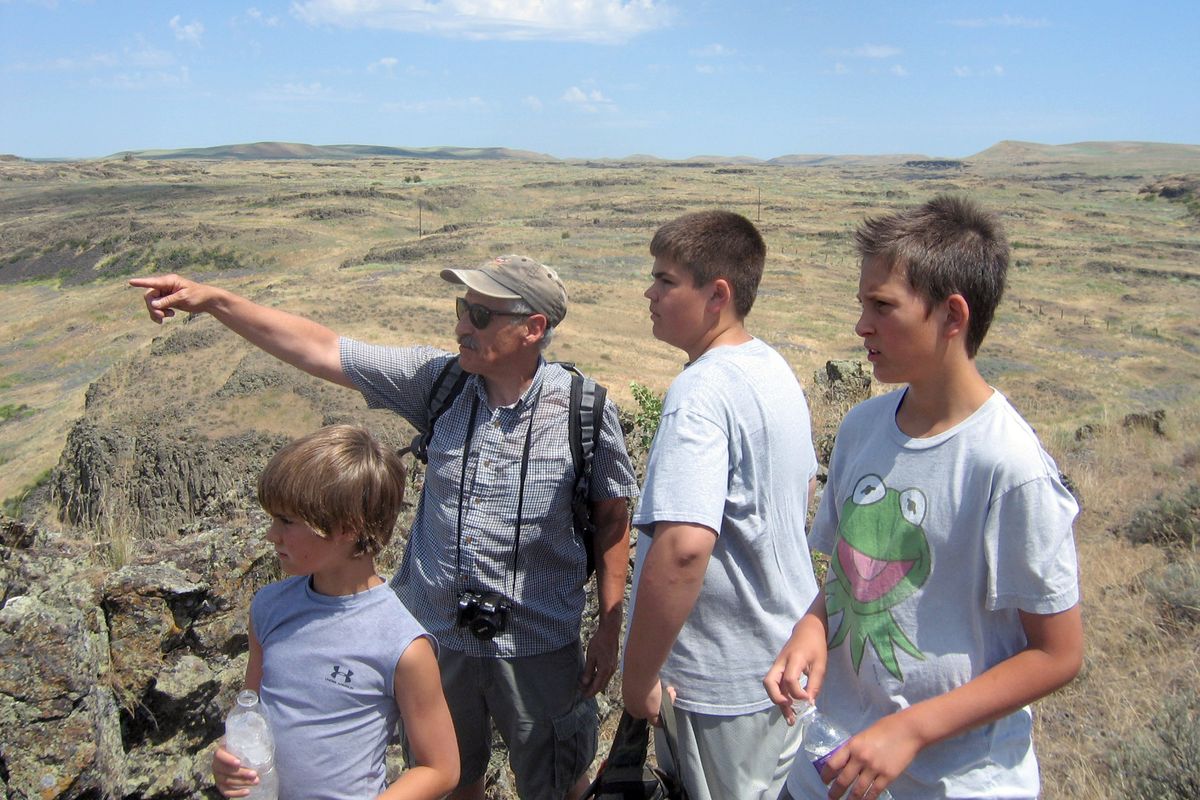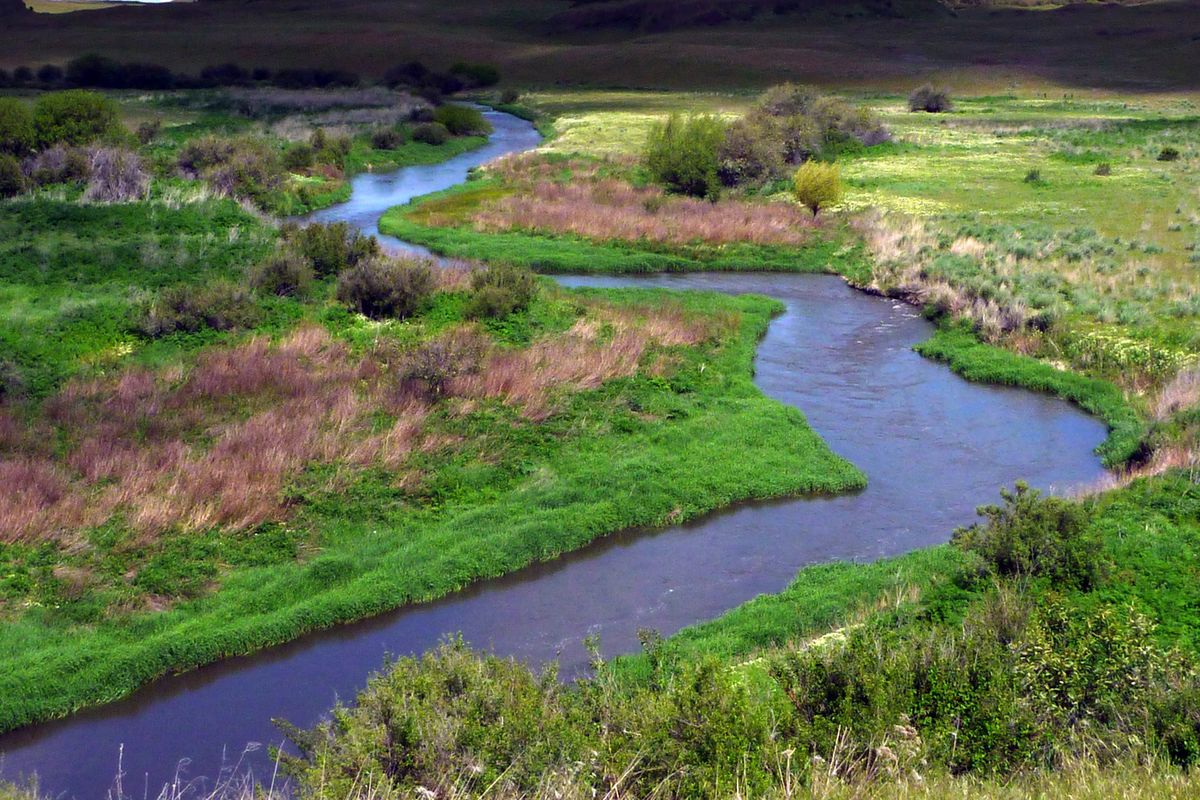Escure Ranch near Sprague offers another unique landscape
EWU anthropology professor Jerry Galm points out topography details at Escure Ranch to Sam Bergam, front left, Max Bergam and Adam Deutsch. (Rebecca Nappi)
For the past two summers, I’ve taken my great-nephews on field trips to see the evidence of the ice age floods that swept through the Inland Northwest in prehistoric times.
We saw the Grand Canyon-ish Dry Falls the first summer. Then, the Niagara-like Palouse Falls the second summer.
In late June, the boys and I – Max, Adam and Sam, Max’s younger brother – ventured to Escure Ranch near Sprague, Wash., to see mesas and Rock Creek, shaped by those long-ago floods.
At Escure Ranch, it’s more difficult to understand what the flood left behind, because the topography, though beautiful, is not as dramatic as Dry Falls or Palouse Falls.
But we had a most excellent guide: Jerry Galm, professor of anthropology at Eastern Washington University.
Galm introduced me to the flood story in 1989 when I met him on a dig. He agreed to be a gracious guide to the great-nephews, ages 9 to 12. Here’s our 2011 great flood tour report:
9:30 a.m. On the drive to the EWU campus, I list the rules for today: “Ask questions. Be polite. Keep the silliness in check. Remember, you are with a real professor this year.”
I give Adam and Max their reporter’s notebooks from last year’s tour. Sam, new to the tour, looks at the pen names Max and Adam have written on their notebooks, which I can’t print here except to say that Beavis and Butt-head would approve.
Sam writes in his pen name, keeping alive the B&B tradition.
10 a.m. Galm greets us warmly. I haven’t seen him for 20 years. His dark hair has turned gray, but he’s fighting fit, as he was back then. He’s 62, and has four teenagers.
In the fall, he’ll mark his 30th year at EWU. Every semester, he’s out in the field with students, climbing, digging, hiking, exploring.
We have an hourlong car ride south of Cheney to Escure Ranch. On the way, Galm tells the flood story in a way that Sam, the newbie, can understand.
“Imagine a big bathtub full of water,” Galm says. “The bathtub was a place called Glacial Lake Missoula. It filled up with water because the glaciers began to melt. When they melted, the lake began to rise and at a place where it was narrow, a lot of ice plugged it up.
“Well, periodically what happened is the ice dam, which plugged up Glacial Lake Missoula, melted, and water began to flow underneath it. It reached a point where it popped the ice up in the air just like a cork. All the water flowed out and down, which took it right through northern Idaho and Eastern Washington and out to the ocean.”
10:20: Some unauthorized seat-changing is going on in Galm’s van, fueling the sillys.
Galm says, “Imagine, guys, water about 300 to 400 feet above this car. That’s how high we think the water was coming through here in the biggest floods.”
The boys picture a skyscraper of water above them. The sillys turn to wows.
10:40: We drive by hills flattened on the tops, called steamboats, shaped by floods that roared through the Inland Northwest at 65 miles an hour. Now, a river flowing at 10 mph is flowing at high speed.
Galm says: “See how these look like boats turned over? That’s what the water did.
“Have you seen ‘Cars’ where the landscapes in the background are shaped like cars? Here we’re in a landscape where it’s shaped like upside-down boats.”
10:45: We go past Revere, now just a grain elevator, and our talk turns to nuclear missiles planted in Eastern Washington hills during the Cold War. Indeed, it begins to feel like a Cold War landscape, after the bomb. No one is around. Not a car. Not a human.
11:12: We turn into Escure Ranch, 20 square miles of land. A family with that name once owned it. In 1999, the Bureau of Land Management purchased the land. Deserted farm buildings look eerie in the distance. Off the parking lot, there is a restroom and three picnic tables.
Mesas surround us. Suddenly, it feels and looks like Arizona.
11:30: We walk along a dirt road that leads to the trail of the tallest mesa. We’re in rattlesnake country now, Galm tells the boys.
“If we see snakes, don’t touch,” he says. “In heat like this, they tend to go to cooler places. So mainly we’ll have rattlesnakes we can’t see, but we can hear them rattling. They are telling us to move back.”
Halfway down the dirt road, Galm shows the boys rocks the size of golf balls and softballs.
“Hey guys, I want you to never look at rocks the same again. Most of the rocks on this trail are black. This beige rock is from North Idaho.”
They were carried here eons ago, on flood waters.
Sam asks: “Was there fish in the flood water?
Galm answers: “Most likely. Salmon go back at least 1 million years.”
Noon: We’ve taken our time on the mesa trail and stop at a currant bush. Galm hands the boys berries.
While climbing over backpack-size black rocks, Galm says if snakes are going to appear from anywhere, it will be here.
The boys – hoping – throw boulders on the rock piles. No rattlers.
At the top of the mesa, Galm stops near a collection of rocks that form a sort of long, low wall.
Max is now 12. Galm tells the boys one theory of this rock formation: Long ago, Native boys about Max’s age climbed to the top of the mesa. Here, they did vision quests which marked the transition from boy to man.
“The rocks were likely part of the boys’ ‘nonsense’ tasks,” Galm says. “Tasks to let the elders know the boys had been where they said they were.”
The view from the top stuns all of us to silence. The rich greens and browns of the surrounding hills, carved into life in those floods long ago, snuggle into the blue sky.
Rock Creek, also created from those floods, looks so vibrant it could star in a Shrek movie.
Sam asks: “If the flood hadn’t happened, the creek wouldn’t be here?”
Galm says: “You’re right. It would be someplace else.”
Max then asks: “Could the floods happen again?”
Galm says: “Yes. Global warming suggests everything is getting warmer, but portions of the Earth could actually get cold again.”
12:45: We rest on top of the hot mesa, swigging water. Galm’s cellphone rings – one of his teens with a question about cooking. Off the phone, he shows the boys flakes from prehistoric tools. Sam finds a deer bone and places it in the bottled-water compartment of his backpack.
Adam says, “I want to live out here. I’d build a house out of logs and rock.”
Max says, “I like civilization.”
At the mention of civilization, we start the climb down the mesa, to the trail, to the parking lot, into the van and then away.
In our almost two hours here, we haven’t seen one other person, one other car. And, to the boys’ disappointment, no rattlesnakes.
Earlier Galm had told the boys that geology students from all over the country travel to the Inland Northwest to see the evidence of the great floods that carved into mountain, hill, river and creek.
“It’s what makes our region unique,” he says. “Not just unique in Washington or in the United States but unique in the entire world.”

